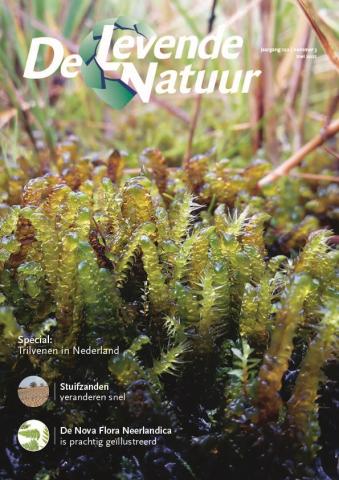De Levende Natuur nummer 3 van 2021 (English summary)
Afbeelding

Chemical characteristics of Dutch poor and rich fens and effects of atmospheric nitrogen deposition
Gijs van Dijk, José van Diggelen, Casper Cusell, Jasper van Belle, Annemieke Kooijman, Tom van den Broek, Roland Bobbink, Ivan Mettrop, Leon Lamers & Fons Smolders
The vegetation composition of Dutch poor and rich fens of terrestrialization peatlands can be divided into six groups, from mesotrophic brownmoss dominated rich fens to acidic sphagnum moss dominated poor fens. The porewater bicarbonate concentration, pH, calcium concentration, groundwater level, and the acid buffering capacity in the soil are important differentiating factors for the vegetation groups. It is very likely that in the Dutch situation, with insufficient supply of base-rich and low-phosphorus surface or groundwater, the succession of rich fens to poor fens is accelerated by increased atmospheric nitrogen deposition, acidification, and desiccation. Accelerated succession is not only a threat to the preservation and development of good quality young succession stages of rich fens, but also to the preservation of the older succession stages such as the (acidified) poor fens and transitional fens. It is therefore important that the current high atmospheric nitrogen deposition levels in the Netherlands are further reduced in the short term.
Loss and new development of rich fens in the Nieuwkoopse Plassen
Gijs van Dijk, Sija Stofberg, Jeroen Mandemakers, Martijn van Schie, Casper Cusell, Annemieke Kooijman & Fons Smolders
The habitat type rich fens (H7140A) has become a rarity in the Netherlands and is under pressure of acidification and eutrophication. The natural area De Haak harboured the last well developed rich fen vegetation in the west of the Netherlands. This rich fen vegetation seemed to have disappeared, while in the neighboring area, the Nieuwkoopse Plassen, management measures seemed to be able to restore and develop rich fen vegetation. This study aimed at finding the causes for decreasing quality of the rich fen vegetation in De Haak. Site conditions in De Haak were compared with the restored and newly developed rich fen vegetations in the Nieuwkoopse Plassen and reference vegetations in other Dutch fens. The results showed that the soil moisture in De Haak, and to a lesser extent in the Nieuwkoopse Plassen, are too weakly buffered. Former water management measures showed both positive effects (decreased phosphorus loads) and negative effects (decreased calcium loads). The present well developed rich fen vegetation shows that restoration and development of rich fen vegetation is possible within the area. However, it was also shown that the surface water is very weakly buffered. Future restoration and development of rich fen vegetation is therefore only possible when the vegetation stays in contact with the (nutrient poor and weakly buffered) surface water to counteract acidification, ecological succession, and atmospheric nitrogen deposition.
Restoring quaking fen vegetation with surface water irrigation
Camiel Aggenbach, Gijsbert Cirkel, Casper Cusell, Gijs van Dijk & Annemieke Kooijman
In terrestrialization mires of the low parts of The Netherlands acidification is a dominant trend causing replacement of rich fen vegetation by Sphagnum and Polytrichum dominated vegetation. Artificial flooding with surface water is a potential measure to preserve and restore a high base status. In a field experiment a controlled flux of surface water was irrigated during four years in a rich fen and a Sphagnum dominated poor fen. In both vegetation types pore water, soil pH and Ca2+ concentration increased significantly up to the range of rich fens. Despite this trend moss species of rich fen did not increase due to strong competition by Sphagnum. For suppressing Sphagnum, flooding with inundation with Ca2+- and HCO3 --rich surface water of the moss layer is needed. Mineral N- and P-concentrations in the pore water were low in the zone with infiltrated surface water and in the range of mesotrophic rich fens. Solute balance calculations for flooding with local surface water in several peatlands and acidification stages were used to assess the potential recovery time of a high base status and risks for eutrophication. When the Ca2+-concentration of the surface water is high (> 1.000 μmol/l) recovery time had a feasible range (1 to16 years) for nature management. In the long term the extra P-loading and strong SO4 2- loading might be a risk for eutrophication. Therefore, flooding with Pand SO4 2--poor water is advised.
Fluctuating water levels and the resurrection of rich fens in the Netherlands
Adam Koks, Gijs van Dijk, Casper Cusell, Suzanne Kanters, Annemieke Kooijman, Fons Smolders, Willem Molenaar & Henk Hut
In the Rottige Meente scorpidium scorpioides dominated rich fen (H7140A) vegetation was restored by actively fluctuating water levels and long-term inundation (weeks). The leading factors causing peatmoss dominated poor fen vegetation to diminish and the development of rich fen vegetation were investigated through a field experiment. This was done by following changes in water levels and porewater chemistry in different vegetation types after actively increasing water levels and inducing inundation. Elevated buffering from inundation with base-rich and nutrient-poor surface water seems to be the leading cause of changes in the vegetation composition resulting in the development of species generally occurring in rich fens. More insights into these processes may lead to new measures for further restoration efforts in other fens in the Netherlands suffering from acidification and desiccation.

